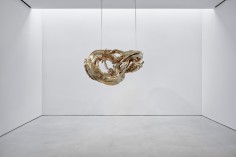WIM DELVOYE
ВИМ ДЕЛЬВУА
维姆·德尔瓦
Dual Möbius Quad Corpus

source: aexchangenet
Wim Delvoye was born in Wervik, Belgium, in 1965. He was not from an especially artistic background, a fact that he feels
allows people to identify with his art in a way that is difficult with more traditional forms. Nonetheless, a love of art was birthed in him from an early age, both through his attendance of museums with his parents and his love of drawing at school. Several of his childhood creation can be found on his highly interactive website and his love of art led him to enrol at art school.
Wim Delvoye was born in Wervik, Belgium, in 1965. He was not from an especially artistic background, a fact that he feels
allows people to identify with his art in a way that is difficult with more traditional forms. Nonetheless, a love of art was birthed in him from an early age, both through his attendance of museums with his parents and his love of drawing at school. Several of his childhood creation can be found on his highly interactive website and his love of art led him to enrol at art school.
.
.
.
.
.
.
.
source: guggenheimorg
b. 1965, Wervik, Belgium
Wim Delvoye was born in 1965 in Wervik, Belgium. Working in such varied mediums as sculpture, drawing, live tattooed animals, stained-glass windows, and X-ray photographs, Delvoye mischievously brings together the extremes of high-brow and low-brow culture. In the late 80s, Delvoye applied Dutch ornamental traditions (i.e. Delft china patterns and coats of arms) to mundane objects like shovels, gas cylinders, and ironing boards. In works like Cement Truck (1990–91) and Delft Concrete Mixer (1992), lavish flourishes adorned larger objects. In his series Mosaics (1990–92), realistic renderings of excrement were used to decorate white ceramic tiles. In 1992, Delvoye began an extensive project in which he exhibited live pigs and dried skins of pigs, both covered in tattoos drawn from the domain of bikers and punk rockers: skulls, daggers, snakes, hearts, and Harley Davidson logos. In 2004, he extended this medium by exhibiting stuffed pigs and by expanding his tattoo vernacular to include Louis Vuitton patterns and images of Disney princesses.
Concurrent to his projects involving tattooed pigs and the eventual establishment of their permanent home at “Art Farm” in Beijing, Delvoye developed several other major projects. From 1998–99, the artist photographed patterns of various sliced meats meticulously assembled to approximate cold, clean marble floors. In his ongoing series of Gothic works, initiated in 1999, Delvoye created stained-glass windows and sculptural works. For the latter, he constructed, in the elaborate International Gothic style, massive equipment typically found on construction sites (a Caterpillar machine, dump truck, flatbed trailer, and cement truck). In 2009, Delvoye built Torre, a Cor-ten-steel tower, with ogival-arched windows, tracery, and turrets, on the terrace of Palazzo Venier dei Leoni, overlooking the Grand Canal, for the Peggy Guggenheim Collection in Venice. The artist’s ongoing project, Cloaca, involves several versions of an original machine completed in 2000, which replicated the digestive system, consuming matter at one end and producing excrement at the other.
Solo exhibitions of Delvoye’s work have been organized by Castello di Rivoli (1991), Kunsthalle Nürnberg (1992), Open Air Museum Middelheim in Antwerp (1997), Centre Georges Pompidou in Paris (2000), Migros Museum in Zurich (2001), Museum Kunst-Palast in Dusseldorf (2002), The Power Plant in Toronto (2004), and Peggy Guggenheim Collection in Venice (2009). His work has also been included in major group exhibitions such as Venice Biennale (1990, 1999, and 2009), Documenta IX (1992), Sydney Biennale (1992), Lyon Biennial (2000 and 2005), and Shanghai Biennale (2006). Delvoye lives and works in Ghent.
.
.
.
.
.
.
source: news99ys
生于1965年的比利时艺术家维姆·德尔瓦,创作素材非常多样,也许最广为人知的作品是他的“下水沟”系列——通过对科学家们的(实验室)试验产生的严谨联想,使得消化过程变得日益清晰。2009年,在威尼斯双年展期间,德尔瓦应邀为佩吉古根海姆收藏机构设计建造过一座纪念碑作品;2010年和2011年,德尔瓦分别在巴黎罗丹博物馆和布鲁塞尔美术宫举办个展。
.
.
.
.
.
.
.
source: rumburru
Итак, в 1965 году, в Бельгии в местечке Вервик (Wervik) родился славный малый, который впоследствии поразит мир своими проектами. Как говорит сам Вим, «we make money not art». Тем не менее, позиционирует он свои проекты как арт-инсталяции. Мне, честно говоря, сложно представить то, что творится в голове этого художника… Остается только восхищаться, или наоборот, поливать грязью его «искусство».
Наверное самый знаменитый его проект, известный во множестве модификаций, форм и размеров, это проект «Клоака» (Cloaca), логотип которого удивительно похож на знаменитого «Мистера мускула». Клоака представляет собой машину, которая моделирует процессы пищеварительного тракта человека. Поговаривают, что на создание такой машины его вдохновил аппарат Digesting Duck, созданный французским изобретателем Жаком де Вокансоном (Jacques de Vaucanson) в 1739 году.

